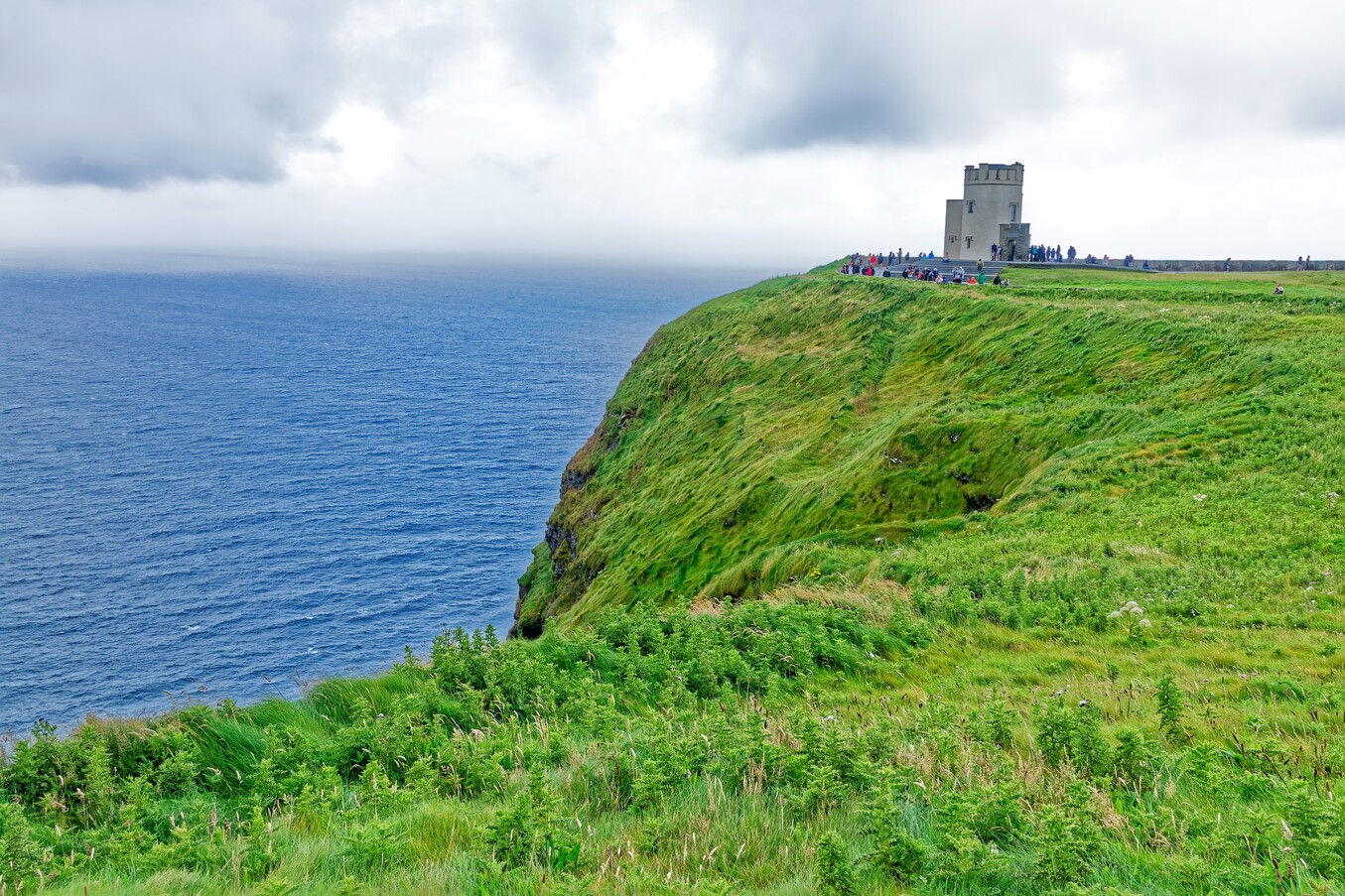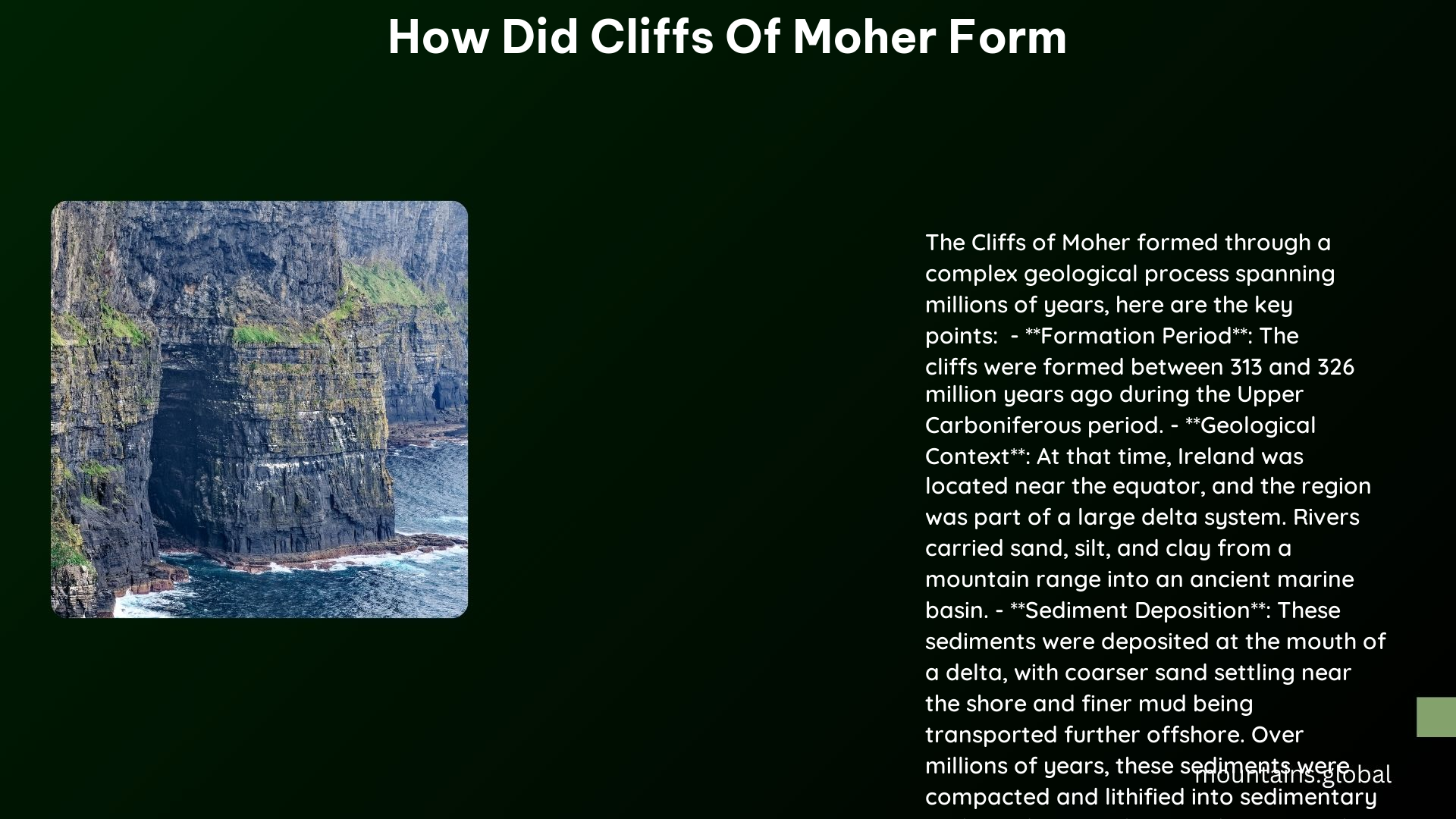The Cliffs of Moher, an iconic Irish landmark, formed over 320 million years through a complex geological process. This process involved limestone deposition in ancient seas, tectonic activity causing rock folding, and extensive erosion by ice sheets and ocean waves. The cliffs showcase unique geological features like cyclothems, fossils, and sedimentary structures, offering a glimpse into Earth’s dynamic past.
What Was the Initial Stage of Cliffs of Moher Formation?

The formation of the Cliffs of Moher began during the Carboniferous Period, approximately 320 million years ago. This initial stage was crucial in laying the foundation for the magnificent cliffs we see today.
What Was the Environment Like During This Period?
During the Carboniferous Period, the area that would become the Cliffs of Moher was submerged under a warm, shallow sea. This ancient marine environment was similar to the present-day Bahamas, teeming with diverse marine life.
How Did the Rocks Form?
The rocks that make up the Cliffs of Moher formed through two main processes:
- Limestone Deposition:
- Skeletal remains of marine organisms like corals, crinoids, and brachiopods slowly accumulated on the sea floor.
-
This process continued for about 20 million years, creating thick layers of limestone.
-
Sediment Deposition:
- A major river system washed sand and silt into the sea.
- This rapid deposition created layers of shales, siltstones, and sandstones.
- These layers formed repeated sequences known as cyclothems, characteristic of a deltaic environment.
What Role Did Tectonic Activity Play in Shaping the Cliffs?

After the initial deposition of sediments, tectonic forces played a significant role in shaping the landscape that would become the Cliffs of Moher.
How Did Continental Collision Affect the Area?
The collision between the ancient continent and what is now Europe had several effects:
- Gentle folding of the rock layers
- Creation of cracks and fissures in the limestone
- Tilting of rocks, visible in locations like Mullaghmore
This tectonic activity set the stage for the next phase of the cliffs’ formation by creating weaknesses in the rock that would later be exploited by erosional forces.
How Did Erosion Contribute to the Cliffs’ Formation?
Erosion has been a major factor in shaping the Cliffs of Moher into their current dramatic form. This process occurred over millions of years and continues to this day.
What Was the Impact of Ice Ages?
The ice ages, beginning about 1.8 million years ago, had a profound impact on the landscape:
- Massive ice sheets over 200 meters thick moved from the north and northeast
- These ice sheets scoured the surface, ripping up soil and rock
- Valleys were carved out by the moving ice
- As the ice melted, it deposited rocks and clay from other regions
How Has Sea Erosion Shaped the Cliffs?
Sea erosion has been a constant force in shaping the Cliffs of Moher:
- Continuous wave action has pounded against the rock face
- This erosion has contributed to the vertical nature of the cliffs
- The process has exposed different layers of rock, revealing the geological history of the area
| Erosion Type | Impact on Cliffs |
|---|---|
| Ice Sheets | Carved valleys, deposited foreign rocks |
| Sea Waves | Created vertical cliff face, exposed rock layers |
| Rainwater | Formed karst features in surrounding limestone |
What Unique Geological Features Can Be Observed at the Cliffs of Moher?
The Cliffs of Moher showcase several remarkable geological features that provide insights into their formation and the Earth’s history.
What Are Cyclothems and Why Are They Important?
Cyclothems are repeated sequences of mudstone, siltstone, and sandstone visible in the cliff face:
- They reflect changes in sea levels and the deltaic environment of their formation
- Thin marine bands with distinctive goniatite fossils separate these sequences
- Cyclothems provide valuable information about ancient environmental conditions
What Is the Fisherstreet Slide?
The Fisherstreet Slide is a unique geological feature at the Cliffs of Moher:
- It’s a distinctive sheet of sedimentary rock that moved as a sedimentary slide
- Contains soft sediment deformation features
- Part of the Gull Island Formation
What Types of Fossils Can Be Found at the Cliffs?
The Cliffs of Moher are rich in fossil evidence:
- Trace fossils, such as burrows made by extinct arthropods and gastropods, are abundant in the Liscannor Flags
- Marine fossils, including those of ancient sea creatures, can be found in various rock layers
- These fossils provide valuable information about the ancient marine ecosystem that existed when these rocks formed
How Can the Formation of the Cliffs of Moher Be Explained to Children?
Explaining the formation of the Cliffs of Moher to children can be an exciting way to introduce them to geological concepts. Here are some key points that can be easily understood by young minds:
- Ancient Sea Story:
- Long ago, the area was covered by a warm sea
- Tiny sea animals lived and died in this sea
-
Their skeletons piled up over millions of years to form rocks
-
Ice Age Adventure:
- Huge sheets of ice, like giant frozen blankets, moved across the land
- These ice sheets carved out valleys and moved big rocks around
-
When the ice melted, it left behind rocks from far away places
-
Wave Power:
- The ocean waves have been hitting the rocks for millions of years
- This constant pounding has made the cliffs tall and straight
-
It’s like the ocean has been sculpting a giant wall of rock
-
Fossil Hunt:
- The rocks in the cliffs contain fossils of ancient sea creatures
- These fossils are like nature’s own history book
- Scientists can study these fossils to learn about life millions of years ago
By presenting these concepts in a storytelling format, children can grasp the immense timescales and dramatic changes involved in the formation of the Cliffs of Moher.
References:
1. Geology – Burrenbeo Trust
2. Geology and Cliffs of Moher Geopark | Quarrying – Official Site
3. Cliffs of Moher – The Geological Society
